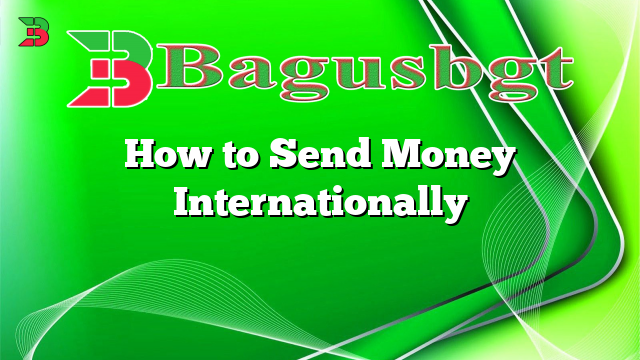Salam and welcome to our guide on how to send money internationally. In today’s interconnected world, sending money across borders has become a common necessity. Whether you need to support family members abroad, pay for international services, or make investments overseas, it’s crucial to understand the process and make informed decisions. In this article, we will discuss various methods, their advantages, disadvantages, and provide you with alternative options. So, let’s dive in!
1. Bank Transfers
Bank transfers are one of the most common ways to send money internationally. They offer convenience, security, and reliability. To initiate a bank transfer, you need the recipient’s bank account details, including the account number and routing information. However, it’s essential to be aware of the high fees associated with international bank transfers, which can vary depending on the banks involved. Additionally, the process may take several business days for the funds to reach the recipient’s account.
2. Online Payment Platforms
With the rise of technology, online payment platforms have gained popularity for sending money internationally. Services like PayPal, TransferWise, and Skrill provide a user-friendly interface and competitive exchange rates. The advantage of using these platforms is the speed of transactions, often taking just a few minutes for the recipient to receive the funds. However, it’s important to note that some platforms charge fees for certain transactions, and the exchange rates may not always be as favorable as those offered by banks.
3. Money Transfer Operators
Money transfer operators such as Western Union and MoneyGram have physical locations worldwide, making them convenient for individuals who prefer in-person transactions. These services allow you to send money internationally within minutes. However, they typically charge higher fees compared to other methods, and the exchange rates may not be as competitive.
4. Cryptocurrencies
For tech-savvy individuals, cryptocurrencies like Bitcoin offer an alternative way to send money internationally. Cryptocurrency transactions provide security, speed, and lower fees compared to traditional methods. However, it’s crucial to consider the volatility of cryptocurrencies and the learning curve involved in understanding how to use them properly.
5. Prepaid Debit Cards
Prepaid debit cards can be a convenient option for sending money internationally. These cards allow you to load funds and provide the recipient with access to the money in their local currency. They offer ease of use and can be reloaded as needed. However, it’s important to research the fees associated with these cards, including activation fees, transaction fees, and currency conversion fees.
6. Mobile Money Transfer
In regions where traditional banking services may be limited, mobile money transfer services have gained popularity. Using mobile wallets, individuals can send and receive money using their smartphones. This method offers convenience and accessibility, particularly in developing countries. However, it’s crucial to ensure the availability and reliability of mobile money services in the recipient’s location.
7. International Money Orders
International money orders are a secure way to send money internationally. They are often used for smaller amounts and can be purchased at post offices or financial institutions. Money orders are relatively inexpensive, but they may take longer to reach the recipient compared to other methods.
8. Foreign Exchange Brokers
Foreign exchange brokers specialize in currency exchange and can offer competitive rates for international money transfers. They often have lower fees compared to banks and provide personalized services. However, it’s important to choose a reputable broker and be aware of any potential risks involved.
9. Peer-to-Peer (P2P) Services
Peer-to-peer services, such as Venmo or Zelle, allow individuals to send money to each other using their mobile devices. While these services are primarily used for domestic transactions, some platforms offer international transfer options. It’s important to check the availability and fees associated with international transfers through P2P services.
10. Cash Pick-Up Services
Lastly, cash pick-up services are an option for sending money internationally. Companies like Western Union and MoneyGram allow recipients to collect cash from designated locations. This method can be useful in situations where the recipient may not have a bank account. However, it’s important to consider the fees and exchange rates associated with cash pick-up services.
Alternative Options
In addition to the methods mentioned above, there are other alternative options for sending money internationally. Some individuals may choose to use international credit cards, traveler’s checks, or even traditional mail services. However, it’s crucial to assess the security, fees, and convenience of these alternatives before making a decision.
Conclusion
In conclusion, sending money internationally requires careful consideration of various factors such as fees, speed, convenience, and security. Each method has its own advantages and disadvantages, so it’s important to choose the one that best suits your needs. Whether you opt for bank transfers, online payment platforms, or alternative options, always research and compare different services to ensure you make an informed decision.
Frequently Asked Questions (FAQ)
| Question | Answer |
|---|---|
| 1. Are bank transfers the most secure way to send money internationally? | Bank transfers are generally considered secure due to strict banking regulations and protocols. However, it’s always important to exercise caution and ensure the accuracy of recipient information. |
| 2. Which method is the fastest for sending money internationally? | Online payment platforms and mobile money transfer services are typically the fastest methods for sending money internationally, with transactions often completing within minutes. |
| 3. Can I cancel a money transfer after it has been initiated? | The ability to cancel a money transfer depends on the service provider and the stage of the transaction. It’s important to check the terms and conditions of the chosen method before initiating a transfer. |
| 4. Are there any limits on the amount of money I can send internationally? | Yes, different methods and service providers may have specific limits on the amount of money that can be sent internationally. It’s important to check these limits before initiating a transfer. |
| 5. How do I track the progress of an international money transfer? | Most service providers offer tracking services that allow you to monitor the progress of your international money transfer. This can often be done online or by contacting customer support. |
We hope this guide has provided you with valuable insights on how to send money internationally. Remember to consider your individual requirements and preferences when choosing a method. Safe travels and happy sending!
 Bagus Banget Collection of the latest information from various reliable sources
Bagus Banget Collection of the latest information from various reliable sources




